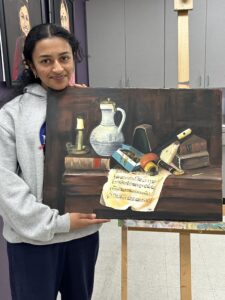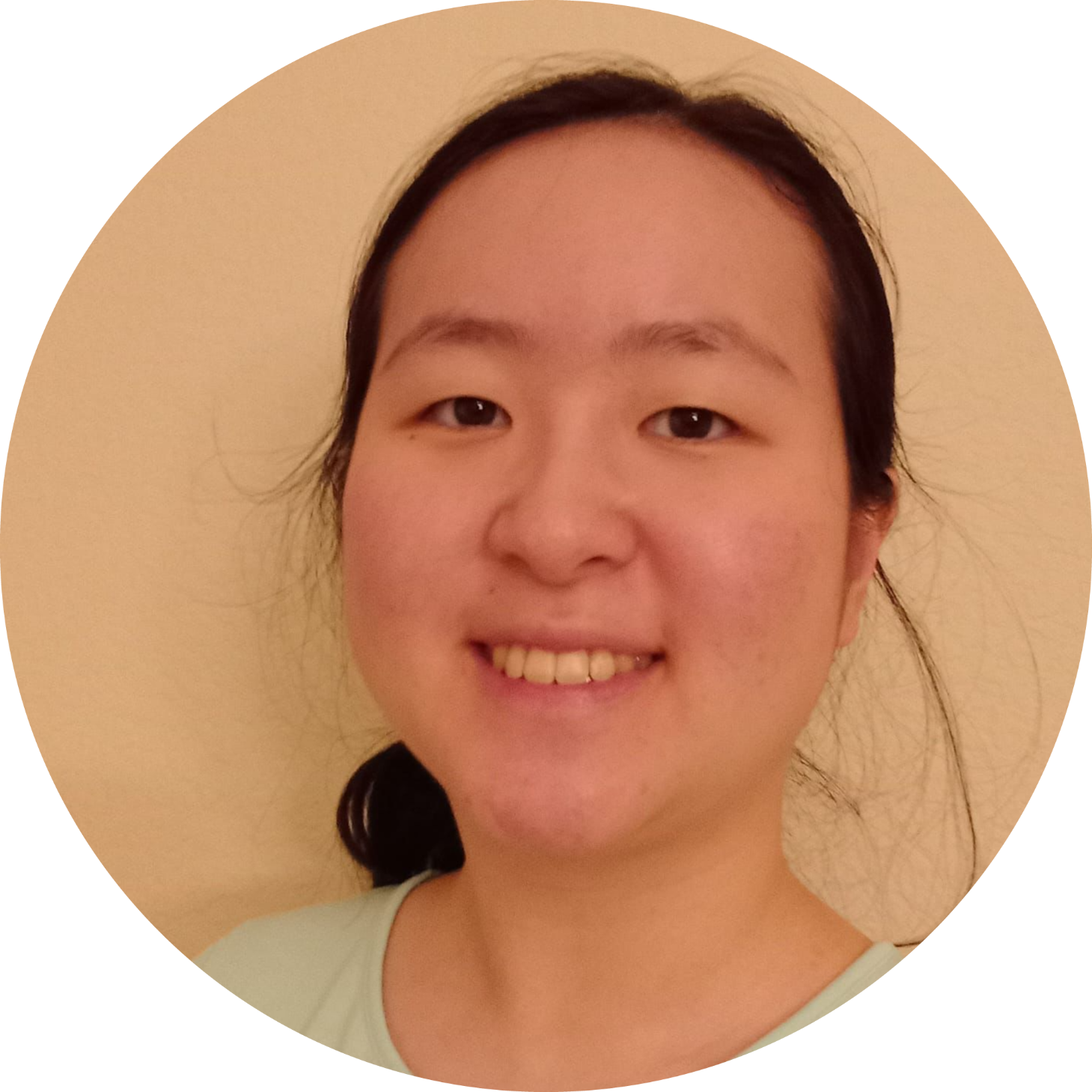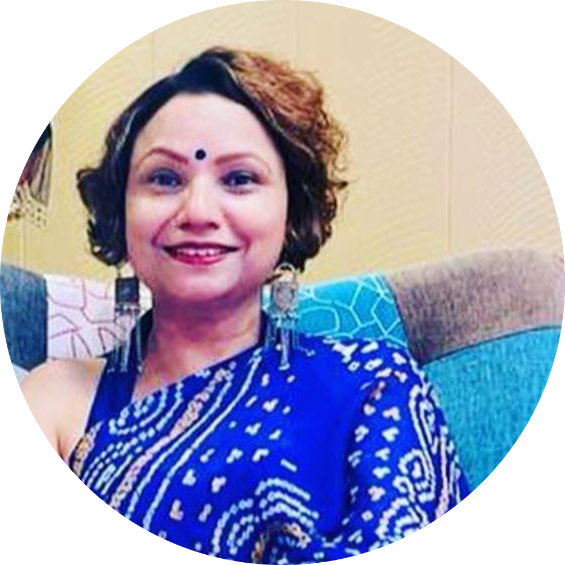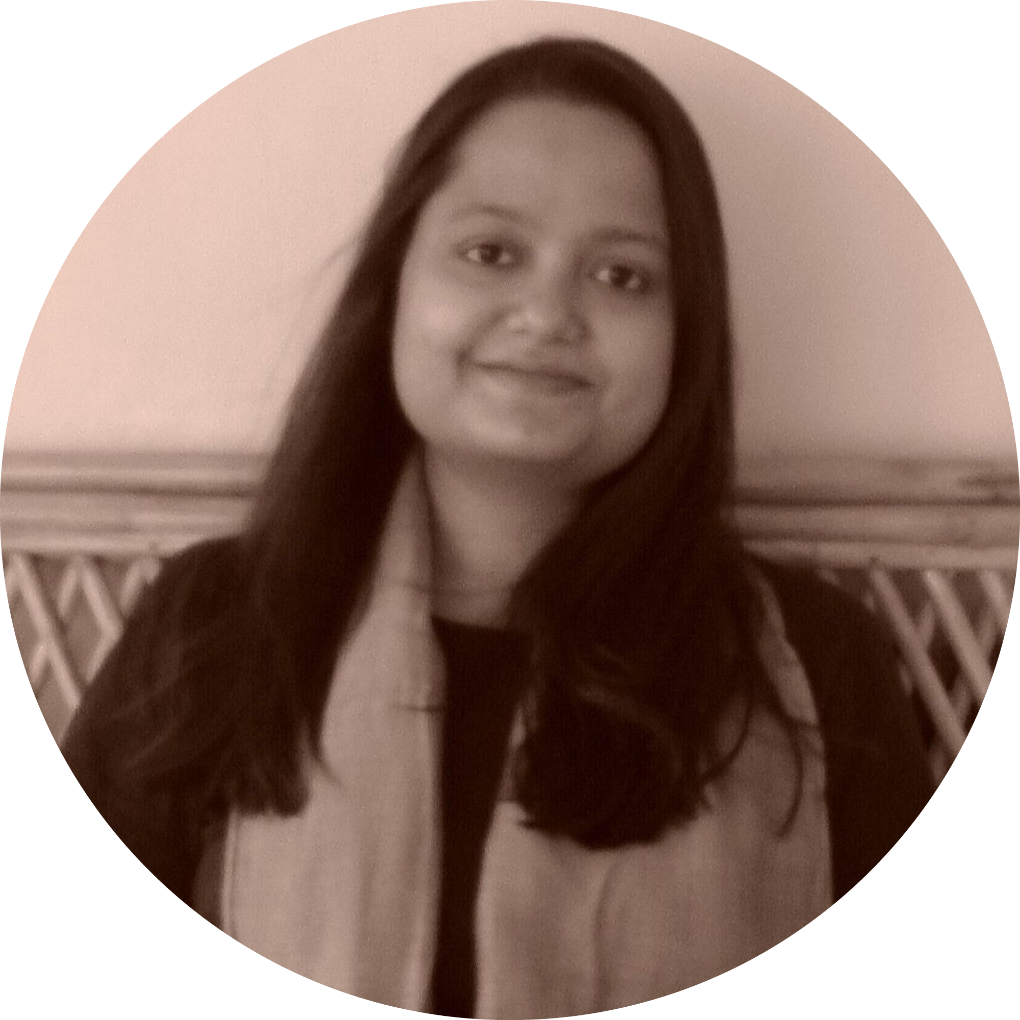Periodt…! periods are not our weaknesses, but our strengths
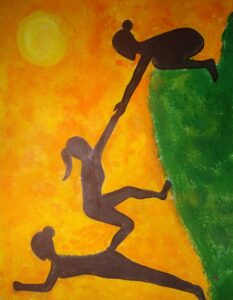
By -Saesha Sharda, Grade 9th When I was a little girl, I was not really encouraged to talk about menstruation, especially in front of my older family members and relatives. Not only was I confused about why periods occur, but also why I wasn’t allowed to talk about it. Now that I’m older and know about periods, I can comfortably talk about them with my parents whenever I have questions or concerns. Menstruation is a fascinating process that happens to almost every single woman on the planet, and I don’t understand why women get shunned for talking about it. Periods are not ‘gross’ or ‘weird’, they’re pretty cool. We need to empower women and encourage them to stand up and talk about light-hearted things like periods, to other heavier topics. My artwork on women empowerment ties into the concept of women helping women. In my artwork, I have shown three women helping each other climb a cliff through a fire. The cliff represents the normal hardships women have to go through, and the fire represents how the outside world makes it harder for women to achieve these tasks. I have used acrylic paint to show a silhouette of the women the background is with acrylic textures. It is important we address things like this through artforms for expressions, I feel it is a step in the right direction. Women are awesome! But, I do understand that the older generation was raised to not talk about women’s’ issues and menstruation, but it is time that changes. Our periods are not our weaknesses, but our strengths; and it’s pretty cool that we get to go through this cycle that perpetuates the entire human species!
Haunted Scene – Op Art

By Saira Siraj This is a Halloween drawing which includes a headstone, haunted house, pumpkins, cemetery, bats, and a tree. On the floor of this artwork, I used an op art technique to create wave-like illusions. In the sky are shapes that are like petals and I colored them with warm colors, red, yellow and orange. The technique that is used in this, is called Op Art. Op Art is short for optical art. Op art is when something is drawn on a piece of paper or on canvas and it looks like it’s moving because their eyes are following the lines. Some famous Op art artists were Vincent Vasarely and Bridget Riley. We first started off by sketching out the haunted house and the main items, such as the tree and the bat. Then we outlined everything as in Sharpie and afterwards, I started making wavy lines on the floor for the optical illusion then we made curves in the waves. Then, I colored every other section to make an alternate pattern. Then, in the sky I made lots of petal shapes coming out of the moon and colored them in the pattern yellow, orange, and red. Then I colored in the windows of the Haunted House yellow and colored everything else in with Sharpie.
Desert Landscape Watercolor Painting
By: Apoorva Kulshreshtha For the month of September, we focused on landscape art work and watercolors. In the painting that I painted, there is a background of a desert with a silhouette of camel and some cacti. The drawing is of an evening sky with the sun that is setting. We learned about how to draw the basic outline of a camel and coloring a sky with watercolors. My favorite part about this artwork was the camel. In 200 AD, camels started to be of use in the Sahara Desert. They carry goods across the Trans-Saharan trade routes. Most of them carried salt, cotton, tea, gold, etc. People used camels because they would dwell in harsh weather and stay without water and food for a long time. People who live in the desert rely on camels for their milk, meat, and fur. For the artwork, we had to mix several colors to get the right colors of the sky. I am proud of how my painting turned out.
My Art experience with disability
By;Aashna Singh In the month of July, my art class decided to do the art project for an international art competition as a disability project under VOSAP. I picked a blind girl with a service dog, the other kids who were in my art class, which was my brother and my cousin, did a color-blind person and a wheelchair person. I picked a service dog because I have a dog at home even though he’s not a service dog he is still part of the working dog category, sledding is not a connection with a service dog some people say but I say sledding is still a fine connection with a sledding dog. I picked a blind girl because blind really has a thing to it, it makes lots of people think about how blind people think like so: what would a blind person see as their family or how do they read? And, how do they understand how to read if they can’t see? How can they learn? Blind people have tough lives. When I was drawing this art project I found a connection. My favorite book series is called Wings Of Fire (WOF) a character from that got blind but learned how to fly dodge trees and know the whole RainWing kingdom. Of Course, it’s just a book. But learning how to do that is just so tough. At my old school, there were these dots that are called Braille. It is 3D and it’s a kind of language so at my school each classroom will have that to help the blind. I felt happy when I submitted my artwork to VOSAP I knew I would never win considering how GOOD my brother was. But still, it was a good feeling to submit it.
Aurora, Magic of Colors
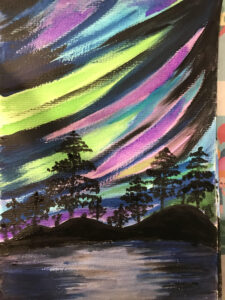
By- Aarav Singh Today I am going to be talking about my artwork based on the Northern Lights, also known as an Aurora. This is the artwork that I did for the fourth week of July 2020, Yes while we all are shelter in place because of COVID 19 Pandemic. I found this artwork inspiring because it shows how beauty can be found anywhere, even in the desolate northern and southern poles. While doing this artwork I was reminded about how many otherworldly phenomena there are on earth. I feel like Auroras are something you have to see yourself to truly believe that they are real. An odd way I’ve thought about Auroras is that they’re like big neon markers that have been drawn in swirls around the sky. Aurora is a natural light display typically found in high-latitude regions and is caused by disturbances in the magnetosphere from solar lights. Typically the magnetosphere keeps most solar lights out, but occasionally some solar lights get in. The atoms in the solar light get excited and once they reach a lower energy state they release a photon: light. These lights create an Aurora. Auroras come in many different colors including; blue, pink, purple, and red. Although Auroras come in all these colors they are most commonly green. Aurora’s are some of the most beautiful and fascinating occurrences in the world. I really enjoyed doing my Aurora project because of the beauty that it has to it and the simpleness. It was an easy project yet it was still alluring. Aurora has always fascinated me and they continue to. For this Project I used Water colors splash and spread technique on paper.
Rani Padmavati, Legend of Honor and Patriotism
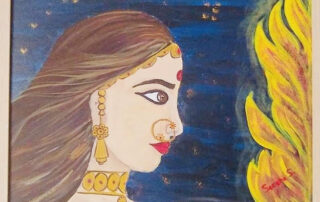
By Saesha Sharda For centuries, women have been underestimated, cast down compared to men, and even ridiculed. Though some change has taken place, sexism towards women still exists. Over the years, women have risen to power by peaceful protesting, hunger strikes, and much more. In fact, the year 2020 celebrates one hundred years of women’s right to vote in America. I wanted to create an artwork showcasing women empowerment. Rani Padmavati is a celebrated Indian icon for women empowerment. Padmavati along with her husband, Ratan Sen, ruled the Mewar Kingdom. Soon after their marriage, a power-hungry king named Allauddin Khilji attacked the Mewar Kingdom. Unfortunately, Ratan Sen was killed during the battle. Padmavati did not want to live under another king’s rule, with a risk of losing her honor or dignity. So, she, along with many other women, jumped into an open pit of fire. Padmavati is a symbol of women’s empowerment because she protected her dignity. In my painting, Padmavati is shown walking confidently into the flames depicts dignity, pride, and values for the motherland…come what may!. It is a reflection of Indian Rajput women preferring their honor in defending their kingdom and dignity against invader Alauddin Khalji.
Hand Dexterity still relevant for highly specialized professions
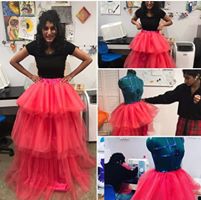
Hand or Manual dexterity is the ability to use your hands in a skillful, coordinated way to grasp and manipulate objects and demonstrate small, precise movements. As per Dr. Roger Kneebone about a worrisome issue affecting medical students in the UK: They show a lack of hand dexterity in simple tasks such as tying knots and cutting string. Hand dexterity is a critical skill for surgeons, yet “It seems we can no longer rely on people having developed these ways of using their hands from early childhood, at home, and at school,” ( https://activeforlife.com/developing-hand-dexterity-in-early-years-essential-for-adulthood/) Experts have suggested that this ineptitude in fine motor skills among the current generation of emerging clinicians and many more professionals may be due to less exposure to knowledge and learning that require practical drawing and craft skills in primary and secondary schools. Dr. Rhea Liang, MBChB, an Associate professor of Surgery specializing in breast cancer at Gold Coast Hospital and Health Service in Robina, Australia, does “wool craft” during lectures to help her listen to and recall information. (The ‘Knitting Lady’ Is a Surgeon and She’s Paying Attention “Unlike Phones, Handiwork Does Not Distract” by-Nick Mulcahy, August 12, 2019, https://www.medscape.com/viewarticle/916712) At present increasing numbers of young kids are just using a keyboard for 90% of their work. they hardly use their thumb for their academic tasks. Using hand and handheld tools for Geometry, Art, writing skills focus on cursive writing, hand embroidery is, becoming obsolete and are no longer mandatory either in schools or at home as a part of the personality growth. Regardless of ability, activities, and skills that focus on dexterity and fine motor skills are important because they help students increase the muscles in their fingers, hands, and wrists, while also increasing coordination. Engaging in skills like embroideries, sewing, cutting, painting, drawing in early life does not necessarily mean that you are going to be a fashion or textiles designer, or, professional in a related field. But, it nurtures your ability to become efficient in certain skills that require high precision, hand-eye coordination, and application of fine motor skills like performing surgery, as quoted earlier. More and more schools are looking into these abilities apart from your perfect score in your academia. Yes! The Dental Admission Test (DAT) contains a section that specifically tests this skill, and during on-campus interviews, most dental school admissions staff will ask you to discuss how you’ve developed your manual dexterity skills. At Kalaa You will get the opportunity to nurture this part of your persona and will help to engage the students creatively and refine their needed skills for the future. These developed portfolios can be used towards college admission : Art Portfolio (3 years Learning skills culminating to Art Portfolio for school admission as Extracurricular activity for a length of time) Painting Exhibition Foundation of Textiles and Fashion Design (2 years Designing/ pattern development/sewing)Needlecraft (2 Years) Blog writing to support your comprehension skills and explanatory ability As the 🌎 stops, hit the gas on! Building your art profile getting access to a unique, personalized training that will bring out the best in you! Shelter in Place, Social distancing is the key! Stay safe, keep your spirits high! Online classes for #Art and #Design Portfolio development for c
Depicting Cubism with Water Colors
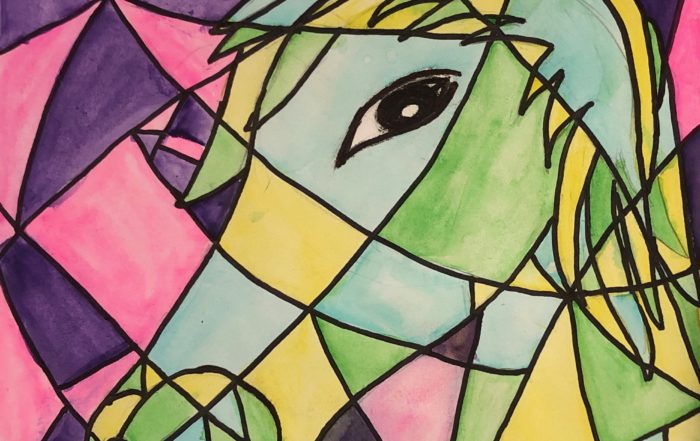
Saanvi Sharma Cubism was first created by Pablo Piccaso and Georges Braque but other artists did take place in the creation of this 20th- century style and movement in art. Cubism is known as the most influential art movement of the 20th century because of how it inspired many related movements in literature, architecture and art. This amazing art style revolutionized European painting and sculpture, and one of the foremost influences that led to Cubism was the representation of three-dimensional forms on a canvas Cubism is supposed to show several different points of view in the rejection of a single viewpoint.It is called Cubism due to the fact that the sections made by random lines to separate the painting into different parts look like cubes and other geometrical shapes. My artwork is a horse in cubism, I first sketched a horse and then drew lines randomly across the page so there were different sections throughout the whole page. Last, for the horse I chose a combination of both warm and cool colors, yellow, green and blue. I used just cool colors for the background, consisting of pink and purple. Endmost, I filled in the different sections with different colors using watercolors. I have made many different sketches and paintings of horses, but this horse that I have drawn in the style of cubism has a whole different meaning. Cubism had given me a different perspective on the world, just the simplest things such as an orange. One would normally see the rich orange color, with the thousands of tiny dimples embedded in it. And the shiny skin when the light is upon it, but walking around it, one will see different views of the whole orange. From front to back, and bottom to top, with the stem. In this case, the horse I drew is different colors, representing the varying shades of when you look at it from one side to another side.
Cubist Horse
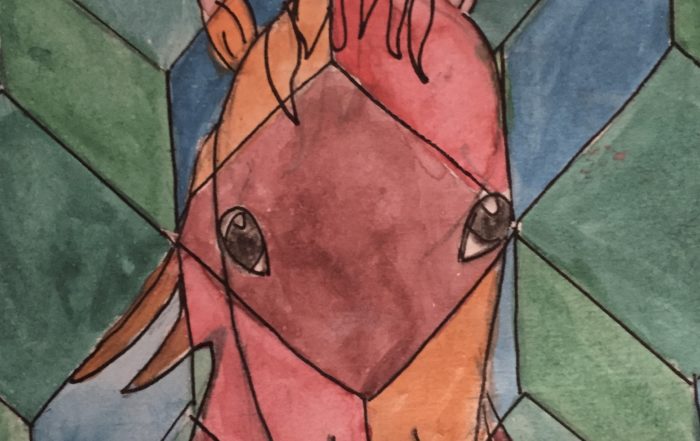
Saira Siraj 6-15-2020 Cubism is an early 20th Century Art Movement in painting. It is a style of art which is supposed to show all of the object’s viewpoints at once. It is called Cubism because the items that are in the artworks look like they are made out of cubes and other shapes. This style of art was first created by Pablo Picasso and Georges Braque. Other artists that were involved in the Cubism art movement are: Salvador Dali, Paul Cézanne, Frida Kahlo, and María Blanchard. My art piece is a horse with an optical illusion. We started by sketching a realistic horse. Then we sketched a cube-optical illusion over it. After that, we chose our color palette for the horse and the background. I chose blue, aqua, and green colors for the background and for the horse I chose orange, purple and pink . This art piece is supposed to show the cubical viewpoint of this horse.
The Three-Eyed Bridge
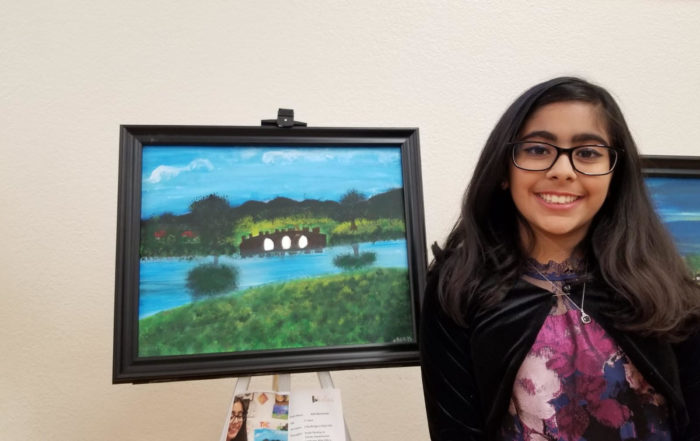
This is a painting of Ruby Hills. It was made by me. I painted this for my 2019 Kalaa Art and Design Exhibition. Theme for this was “My City My Home” I chose this as this landscape shows beauty of my city, and my home which of course, is Pleasanton. That is why I decided to make this bridge. Just the water in itself symbolizes so much to me like the purity and the reflection. The texturing of the hills and the grass are another one of my favorite parts about my creation. To make a painting like this takes several days. You have to paint the blue over the whole canvas, then sketch out the hills and the bridge. Next, you have to texture the trees and hills. After this, you have to make the reflection of the trees and water wash the whole river part. Then add definition and clouds in the sky. This painting was hard work and took many days but I am proud of how it turned out. I was very happy when my art was displayed at an exhibition and hope to continue making many more great pieces of artwork.


